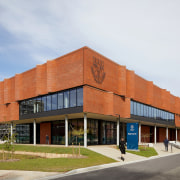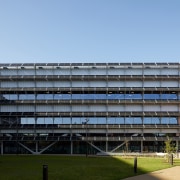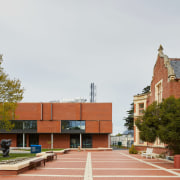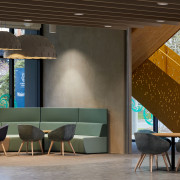Lean and green
Waimarie Lincoln University Science Facility, by Warren and Mahoney, creates an epicentre for advancing land-based disciplines – the demonstrably green hub walks the talk
Designed by Warren and Mahoney
From the architect:
The newly opened Waimarie building creates state-of-the-art science facilities and modern learning environments for the next generation of scientists.
The project places science on display at the heart of the Lincoln University campus; breaking the barriers for sharing research between scientists, academics and students alike.
Playing a pivotal role in the decarbonisation journey of the Lincoln University Campus, the building harnesses all-electric systems, bolstered by heat recovery and a centralised ground source heating and cooling plant.
The efficiencies achieved by using stabilised aquifer result in economic building performance and operating efficiency.
The workplace elevations wear their sustainability credentials clearly on their facades, with PV panels covering the entire north facing elevation.
In an innovative response to tight cost constraints, Warren and Mahoney collaborated with Meridian and Reid technologies to maximise a solar rent-to-own model.
Not only does the 208KWp DC Solar array supplement the energy consumption of the building, but it provides solar and glare control, and maximises amenity for its users, who can take advantage of the wonderful rural outlook.
Located close to Te Waihora (Lake Ellesmere) the project team worked with Lincoln University and Mana Whenua to help shape the project sustainability aspirations.
Acknowledging water as a precious resource, rainwater harvesting, stormwater attenuation, filtration and purification were carefully integrated to reduce runoff into the surrounding waterways.
The team worked closely with local artist Piri Cowie and Taumutu Runanga to weave in narratives of early occupation and the cultivation of Te Waiponamu
When tasked with designing a facility to enhance scientific progress in the arable land-based sector, we considered how the building itself can align with and support the sector’s goals.
Internally, the spaces provide a progressive model for industry collaboration, while the construction of the spaces prioritise the support of local industry.
The Canterbury Clay brick façade was extracted and made within the Selwyn district.
Trees felled from site were milled and reused as internal finishes.
The building is insulated with 10 tonnes of locally made Terralana Wool insulation; and the supplier of the 100% NZ wool carpet is owned by over 700 Kiwi wool growing farming families.
Working to a tight cost envelope, key architectural outcomes and materials have been selected strategically to deliver the biggest impact.
For cost efficiency, Warren and Mahoney employed a reductive design approach, which expresses the structure and building systems.
To reduce embodied carbon and increase resilience, the design team integrated an innovative Tectonus seismic dampening solution that decreased the steel weight, reduced the foundation depth and offered advantages in terms of the downstream effects to movement throughout the building.
The digital design coordination on this project is exemplary and industry leading.
The design team collaborated directly with Leighs Construction and their subcontractors during the detailed design phase to 3D model to compliant real-life tolerances using specific product specifications rather than generic performance specifications.
During the design phases, the team resolved 61,000 clashes that streamlined onsite installation and 850 architectural drawings were prepared to describe the complex project requirements.
Credit list
Project
Construction
Architect
Home kitchen bathroom commercial design

















